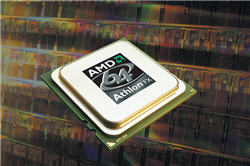AMD Quad FX platform - Sounds good in theory, but ...

AMD have released official details of the Quad FX platform (previously known as 4x4). The Quad FX platform features AMD’s Dual Socket Direct Connect (DSDC) architecture to deliver dual-socket, multi-core processing for "megatasking enthusiasts".
The 4x4 platform was initially being pushed as to gamers, but AMD is now broadening the scope to include those who edit audio/video and stream high-definition content. There is also a new term to get used to - "megatasking". This means running multiple, demanding applications and multi-threaded games.
[poll id=43]"The emergence of a dual-socket consumer platform is critical for enthusiasts who demand systems that offer the sheer power and system headroom to let the enthusiast configure this system to his or her heart's content, and launch a fleet of entertainment and productivity applications at once," said Bob Brewer, corporate vice president, Desktop Division, AMD. "AMD is redefining performance by enabling our customers to take advantage of the amazing megatasking capability of two AMD Athlon 64 FX-70 series processors in the AMD Quad FX Platform."
At the heart of Quad FX are AMD's new CPUs - the new Athlon 64 FX-70 series. Pricing for pairs of the new AMD Athlon 64 FX-70, FX-72 and FX-74 dual-core processors is $599, $799 and $999, respectively.
Joining AMD with the launch of Quad FX is NVIDIA which is also launching its nForce 680a MCP for Quad FX systems. The nForce 680a MCP Quad FX systems has a total of 56 PCIe lanes and 12 links. In real terms this means four PCIe x16 slots with two full-speed and two half-speed slots, and eight additional PCIe x1 lanes for other cards. A total of 20 PCI slots are supported, but I don't see that being fully utilized on any motherboard.
The nForce 680a also supports a 12 SATA 3.0Gbps ports allowing for up to 7TB of storage (RAID levels 0, 1, 0 + 1, 5 and JBOD are supported). Add to that four PATA devices on two channels and you have enormous storage capabilities.
This motherboard doesn't come cheap though. Expect to pay close to $500 for it.
It doesn't end there. 20 High-speed USB ports. Four Gigabit Ethernet controllers. High definition audio. Up to eight monitors powered by up to four PCI-E graphics cards. Impressive. The more I read about Quad FX, the more I like it. Not so much because of the FX-70 CPUs but because of the amazing scope that if offers motherboard manufacturers. Finding a suitable chassis and cooling the rig might be an issue though (Thermaltake have two chassis that are suitable - the Kandalf Extreme Edition and the Armor Extreme Edition).
Here comes the "but" ...
But ... don't get too excited though. The motherboard sounds great but the performance from the CPU seems lackluster at best. The reviews have started to hit the web and it seems that if you want power, the CPU to go for is the Intel QX6700 2.66 GHz quad core which manages to beat two FX-74 3.0 GHz processors running flat out. The FX-74 also has little or no scope for overclocking either. Add to that high platform costs and the need for a 750W or bigger PSU, it seems that AMD are going to have a hard time convincing hardcore enthusiasts to part with their money - if you're buying with your head, Intel wins, if you're buying with your heart, you might buy AMD. AMD is certainly going to need to work the marketing magic on this one. My ZDNet blogging colleague George Ou has much more to say about this in his latest post - "AMD Quad FX slaughtered by a single Intel CPU".
Still want it? You'll have to wait until "early 2007" if you want a Quad FX rig. You'll also need to be running Windows Vista Ultimate.
AMD press release here.
